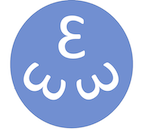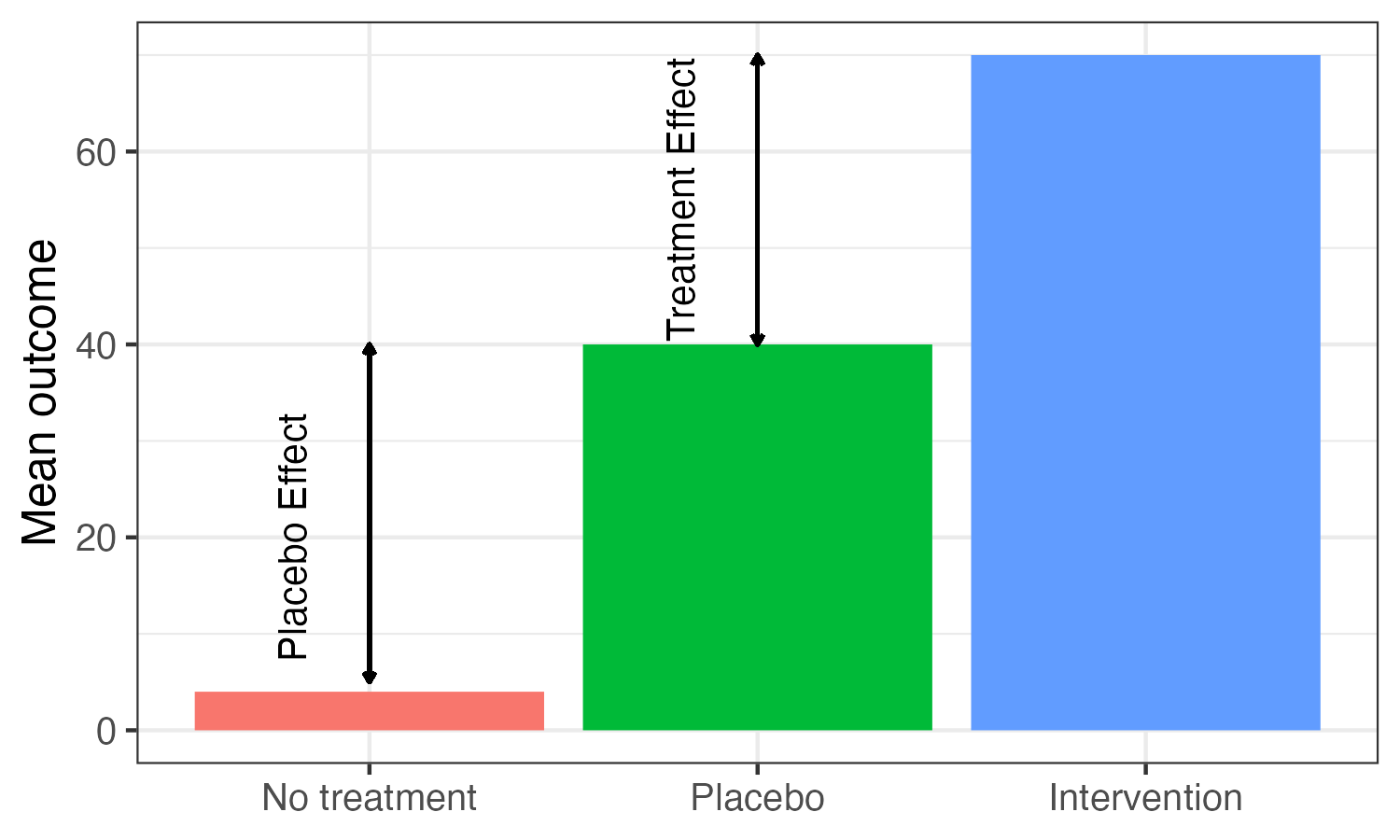Chapter 4 Improvement due to nonspecific effects of intervention

4.1 Learning objectives
By the end of this chapter, you will be able to:
Be aware of non-specific intervention effects and how these can be separated from the specific impact of an intervention.
Understand the concept of mechanism measures, as distinct from broader outcome measures.
4.2 Placebo effects
Most of us are familiar with the placebo effect in medicine: the finding that patients can show improvement in their condition even if given an inert sugar pill.

Figure 4.1: Placebo effect in a three-arm parallel group trial
Figure 4.1 shows outcomes of a simulated drug trial that compared three groups of people (‘arms’ of the trial) who were given either no treatment, and inert pill (placebo) or an active pill (intervention). We see a sizable difference between no treatment and placebo. To evaluate the true treatment effect, over and above the placebo effect, we need to compare the outcome of the intervention condition with the outcome of the placebo condition.
There is much debate about the nature of placebo effects – whether they are mostly due to the systematic changes discussed in Chapter 2, or something else. They are thought to operate in cognitive and behavioural interventions as well: communication may improve in a person with aphasia because they have the attention of a sympathetic professional, rather than because of anything that professional does. And children may grow in confidence because they are made to feel valued and special by the therapist.
The Hawthorne Effect?
The placebo effect in behavioural interventions is often discussed in conjunction with the Hawthorne effect, which refers to a tendency for people to change their behaviour as a result of simply being the focus of experimental attention. The name comes from the Hawthorne Works in Cicero, Illinois, where a study was done to see the effects of lighting changes and work structure changes such as working hours and break times on worker productivity. These changes appeared to improve productivity, but subsequent work suggested this was a very general effect that could be produced by almost any change to working practices. However, there is a twist in the tail. The original factory studies on the Hawthorne effect have been described as “among the most influential experiments in social science”. Yet, like so many classic phenomena in social science, the work attracted critical scrutiny years after it was conducted, and the effect turns out to be far less compelling than was previously thought. The paper “Was there really a Hawthorne effect at the Hawthorne plant?” (Levitt & List, 2011) describes how the authors dug out and reanalysed the original data from the study, concluding that “an honest appraisal of this experiment reveals that the experimental design was not strong, the manner in which the studies were carried out was lacking, and the results were mixed at best…”.
Most therapists would regard such impacts on their clients as entirely valid outcomes of the intervention – boosting functional communication skills and confidence are key goals of any intervention package. But it is important, nevertheless, to know whether the particular intervention adopted has a specific effect. Many individualized speech/language interventions with both adults and children involve complicated processes of assessment and goal-setting with the aim of achieving specific improvements. If these make no difference, and the same could be achieved by simply being warm, supportive and encouraging, then we should not be spending time on them.
Generalized beneficial effects of being singled out for intervention can also operate via teachers. In a famous experiment, Rosenthal & Jacobson (1968) provided teachers with arbitrary information about which children in their class were likely to be “academic bloomers”. They subsequently showed that the children so designated obtained higher intelligence test scores at a later point, even though they had started out no different from other children. In fact, despite its fame, the Rosenthal and Jackson result is based on data that, by modern standards, are far from compelling, and it is not clear just how big an effect can be produced by raising teacher expectations (Jussim & Harber, 2005). Nevertheless, the study provides strong motivation for researchers to be cautious about how they introduce interventions, especially in school settings. If one class is singled out to receive a special new intervention, it is likely that the teachers will be more engaged and enthusiastic than those who remain in other classes where it is “business as usual”. We may then be misled into thinking that the intervention is effective, when in fact it is the boost to teacher engagement and motivation that has an impact.
Study participants themselves may also be influenced by general positive impact of being in an intervention group – and indeed it has been argued that there can be an opposite effect – a nocebo effect – for those who know that they are in a control group, while others are receiving intervention. This is one reason why some studies are conducted as double blind trials – meaning that neither the participant nor the experimenter knows who is in which intervention group. But this is much easier to achieve when the intervention is a pill (when placebo pills can be designed to look the same as active pills) than when it involves communicative interaction between therapist and client. Consequently, in most studies in this field, those receiving intervention will be responding not just to the specific ingredients of the intervention, but also to any general beneficial effects of the therapeutic situation.
4.3 Identifying specific intervention effects by measures of mechanism
There are two approaches that can be taken to disentangle nonspecific effects from specific impact of a particular intervention. First, we can include an active control group who get an equivalent amount of therapeutic attention, but directed towards different goals - equivalent to the placebo group in Figure 4.1. We will discuss this further in Chapter 6, which focuses on different approaches to control groups. The second is to include specially selected measures designed to clarify and highlight the active ingredients of the intervention. We will refer to these as ‘mechanism’ measures, to distinguish them from outcome measures. This topic is covered more formally in Chapter 16.2, where the idea of mediators and moderators of intervention effects will be discussed. Here we give a couple of examples of how additional measures can be incorporated into a study to help distinguish specific intervention effects from general improvement.
Let’s take the example of parent-based intervention with a late-talking toddler. In extended milieu therapy, the therapist encourages the parent to change their style of communication in naturalistic contexts in specific ways. The ultimate goal of the intervention is to enhance the child’s language, but the mechanism is via changes in the parent’s communicative style. If we were to find that the child’s language improved relative to an untreated control group but there was no change in parental communication (our mechanism measure), then this would suggest we were seeing some general impact of the therapeutic contact, rather than the intended effect of the intervention.
To take another example, the theory behind the computerized Fast ForWord® (FFW) intervention maintains that children’s language disorders are due to problems in auditory processing that lead them to be poor at distinguishing parts of the speech signal that are brief, non-salient or rapidly changing. The intervention involves exercises designed to improve auditory discrimination of certain types of sounds, with the expectation that improved discrimination will lead to improved general language function. If, however, we were to see improved language without the corresponding change in auditory discrimination (a mechanism measure), this would suggest that the active ingredient in the treatment is not the one proposed by the theory.
Note that in both these cases it is possible that we might see changes in our mechanism measure, without corresponding improvement in language. Thus we could see the desired changes in parental communicative style with extended milieu therapy, or improved auditory discrimination with FFW, but little change in the primary outcome measure. This would support the theoretical explanation of the intervention, while nevertheless indicating it was not effective. The approach might then either be abandoned or modified – it could be that children would need longer exposure, for instance, to produce a clear effect.
The most compelling result, however, is when there is a clear difference between an intervention and a treated control group in both the mechanism measure and the outcome measure, with the two being positively related within the treated group. This would look like good evidence for a specific intervention effect that was not just due to placebo.
It is not always easy to identify a mechanism measure – this will depend on the nature of the intervention and how specific its goals are. For some highly specific therapies – e.g. a phonological therapy aimed at changing a specific phonological process, or a grammatical intervention that trains production of particular morphological forms, the mechanism measure might be similar to the kind of “near transfer” outcome measure that was discussed in Chapter 3 – i.e., a measure of change in performance on the particular skill that is targeted. As noted above, we might want to use a broader assessment for our main outcome measure, to indicate how far there is generalization beyond the specific skills that have been targeted.
4.4 Check your understanding
In their analysis of the original data on the Hawthorne effect, Levitt & List (2011) found that output rose sharply on Mondays, regardless of whether artificial light was altered. Should we be concerned about possible effects of the day of the week or the time of day on intervention studies? For instance: Would it matter if all participants were given a baseline assessment on Monday and an outcome asssessment on Friday? Or if those in the control group were tested in the afternoon, but those in the intervention group were tested in the morning?
EasyPeasy is an intervention for preschoolers which “provides game ideas to the parents of preschool children to encourage play-based learning at home, with the aim of developing children’s language development and self-regulation”. In a report by the Education Endowment Foundation, the rationale is given as follows: “The assumption within the theory of change is that the EasyPeasy intervention will change child self-regulation which will lead to accelerated development in language and communication and improved school readiness. The expectation is that this will be achieved through the nursery teachers engaging with the parents regarding EasyPeasy and the parents engaging with their children through the EasyPeasy games. As well as improved self-regulation and language and communication development from playing the games, the expectation is that there will also be an improved home learning environment due to greater parent-child interaction. The expected impact was that this will lead to an improvement in children’s readiness to learn along with improved parental engagement with the school”.
Suppose you had funds to evaluate EasyPeasy. What would you need to measure to test the theory of change? Which measures would be mechanism measures and which would be outcomes? What would you conclude if the outcomes improved but mechanism measures showed no change?